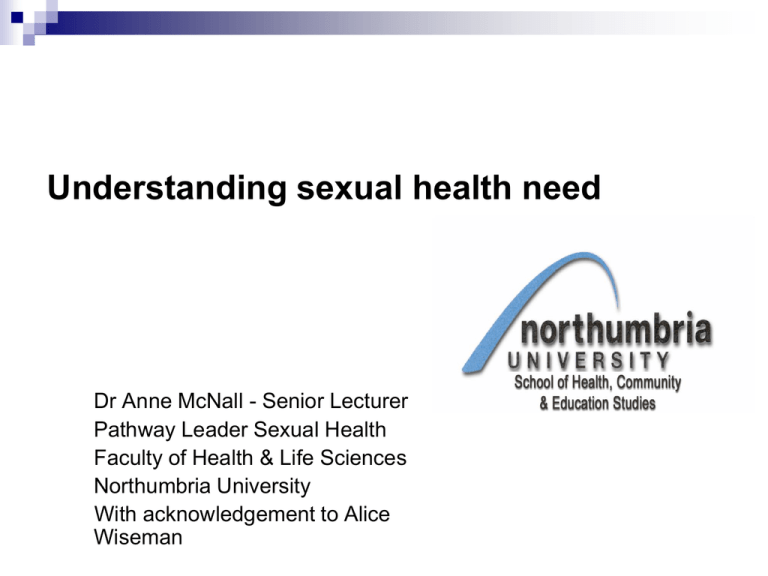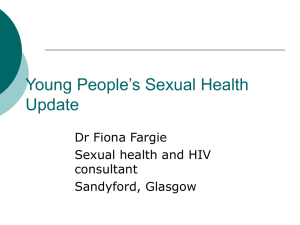
Understanding sexual health need
Dr Anne McNall - Senior Lecturer
Pathway Leader Sexual Health
Faculty of Health & Life Sciences
Northumbria University
With acknowledgement to Alice
Wiseman
This session aims to give;
A brief overview of;
The concept of need
Common frameworks for health needs assessment
The drivers for public and patient involvement and engagement
The impact of stigmatising issues on involvement and engagement.
The diversity of approaches required to understand sexual health
need
The dimensions of need (Bradshaw
Epidemiological need:
Normative need:
experience and examples from other settings which demonstrate
benefits to the public
Felt need:
professional and expert’s views of the interventions and services
which would benefit the public
Comparative need:
measurements of health status to analyse what interventions
and services could be beneficial now and in the future
public and users views of services and actions which would be
beneficial to them
Expressed need:
Public and users views that become publicly known through
research, lobbying or other means
Iceberg of Need (Donaldson 1993)
Services available and
needs are being met
Unmet needs exist
because people are
either not using
services which can help
them or because
appropriate services
are not available that
adequately respond to
health need
What is HNA?
‘Health Needs Assessment (HNA) is a
systematic way for reviewing the health
issues facing a population, leading to
agreed commissioning priorities that will
improve health and wellbeing and reduce
inequalities’
(GBDH 2007 pg7)
Why undertake HNA?
Underpinning the whole HNA process are three principles:
Improvement of health and inequalities by making changes that
improve the most significant conditions or factors affecting health,
then targeting the population groups with the most to gain, and
those services that can make the most difference to their needs.
Integration of this improvement in health into the planning process
used by those services, so that the identified changes are
implemented in their plans.
Involvement of:
people who know the health issues in a community
people who care about those issues
people who can make changes happen
Source: Cavanagh, S. Chadwick K (2005) Health
Needs Assessment: A Practical Guide. NICE
Standardised approach to HNA
Community profile – a description of the target population and
the health issue to be addressed
Epidemiological Needs Review of relevant
health information for the identified
population (including current, past and
predicted trends and cost effectiveness
information about different services and
technologies)
Comparative needs Describe the scope
and nature of services currently available to
the population and compare those with
services provided elsewhere
Public views Results of previously published /
recorded surveys, interviews, focus groups or
commission / undertake your own research
including participatory appraisal
Normative or expert needs Views of local,
national or international experts. Published
guidelines, policies and regulations.
Conclusions and recommendations Review the information collected in the grid above
and draw conclusions about the population needs
From Cavanagh & Chadwick (2005)
Legal requirement for PPI
Section 11 of the Health and Social Care Act (DH 2001):
places a legal duty on the NHS to involve and consult patients and
public in the planning and development of health services and in
making decisions that affect the way those services operate
this duty has been a legal requirement since January 2003
The National Health Service Act. (DH 2006)
Section 242 places a duty on NHS trusts, Primary Care Trusts and
Strategic Health Authorities to make arrangements to involve and
consult patients and the public in the planning and organization of
services
Recommended Standards for Sexual
Health Services
Commissioners and Services should:
“Promote active user participation and involvement
in the planning and organization of services.
Develop their understanding of the various
communities they serve.
Recognize and respond to social exclusion,
discrimination and power imbalances (such as those
between genders or individuals) in a way that enhances
access, and promotes effective use of services.
Ensure all staff involved in sexual health services are
committed to non-discriminatory working practices and
delivery of care” (MedfASH 2005, p33)
Sexual Health Needs Assessment :A how to
guide (Design Options 2007)
Rapid
Review existing data:
Reports, surveys and
analysis
Comprehensive
Existing data: Service
data and context data
Intelligence gathering
Gap analysis
Establish an expert
panel
Review existing data: Reports
surveys and
analysis
Existing data: Service
data and Context Data
Stakeholder analysis and
service mapping
Key informants
Discussion
Involve Users and Potential
Users
Gap Analysis
A hierarchy of participation (Hart 1996)
Mode of participation
Involvement of local people
Relationship of research and
action to local people
Co-option
Token; representatives are chosen,
but no real input or power
On
Compliance
Tasks are assigned, with
incentives; outsiders decide
agenda and direct the process
For
Consultation
Local opinions asked;outsiders
analyse and decide on a course of
action
For /with
Co-operation
Local people work together with
outsiders to determine priorities;
responsibility remains with
outsiders for directing the process
With
Co-learning
Participatory
approaches
Local people and outsiders share
their knowledge, to create new
understanding, and work together
to form action plans, with facilitation
With/by
Why do people access sexual
health services?
A range of reasons which may include;
Sexually transmitted infection
Sexually assault/ abuse
Unintended pregnancy, may want an abortion
Sexual difficulty, eg. erectile dysfunction
Contraception/ Condoms
HIV positive
Just as many people with sexual health need
never access services (NATSAL 2000)
What is known about the needs of service
users in the context of sexual health?
Comparatively little is known about sexual health service
user views
Studies* identify expressed sexual morbidity, perceived
stigma, unmet needs and dissatisfaction with the
diagnosing health care providers counselling on
emotional and sexual issues
Sexual health patients can feel responsible that their
problem(s) result from their own behaviours or
inadequacies, commonly feel guilt and shame, perceive
stigma and are reluctant to give negative feedback, and
therefore could reasonably be defined as disempowered
(silent discourse).
* Evans & Farquhar (1996), Duncan et al (2001), Scoular et al (2001), Nack (2001), Dixon- Woods (2001)
DH (2010) Equality Impact Assessment
for National Sexual Health Policy
Known sexual health inequalities in and within
various communities, eg.
Young
concerned about confidentiality, often access services after sexual debut,
access more difficult for <16s, like one stop shops with multiple services
provided, non judgemental service
BME
people
communities
stigma and lack of culturally appropriate information and services is a barrier
to access/ engagement. Under use of services by core groups of the BME
community, LGBT BME YP less likely to discuss
Mac an Ghaill & Hayward (2005) Samayanga (2007) Serrant- Green (2005)
DH (2007)
Men who have sex with men (MSM)
Prisoners & young offenders
Commercial sex workers......and all groups with known
inequalities
Which methods are used to identify
need in the context of sexual health?
Reliance on;
Epidemiological evidence (statistics)
Surveys/ questionnaires to demonstrate satisfaction with what is offered
Some use of mystery shoppers to evaluate existing services
Limited number of studies which explore experiences of specific groups
Known limitations on getting such research into practice
(McNall 2012, Baraitser 2003)
There is little evidence that what is known leads to
significant change in the information and services
provided
Within any community there is great diversity of need –
one size does not fit all!
Participatory approaches are needed to supplement
epidemiological evidence of need.
Impact of needs led commissioning
What do we commission
already?
SUPPLY
DEMAND
MET needs i.e.
COMMISSIONED
already
UNMET needs
i.e. a GAP
What do we want to
commission in future ?
NEED
COMMISSIONING
More needs MET
i.e. commissioned
Iceberg
of
Need
Iceberg
of
Need
Smaller GAP
i.e. fewer UNMET
needs
Published March 2013
Local Authorities will
Commission
Clinical
Commissioning
Groups
NHS Commissioning
Board
Comprehensive sexual
health services, including:
Contraception,
including LESs (implants) and
NESs (intrauterine
contraception) including all
prescribing costs –
but excluding contraception
provided as an additional
service under the GP contract
• STI testing and treatment,
chlamydia testing as part of
the National Chlamydia
Screening Programme and
HIV testing
• sexual health aspects of
psychosexual counselling
• Any sexual health specialist
services, including young
people's sexual health and
teenage pregnancy services,
outreach, HIV prevention and
sexual health promotion work,
services in schools, colleges
and pharmacies
most abortion services (but
there will be a further
consultation about the best
commissioning arrangements
in the longer term)
Contraception provided
as an additional service under
the GP contract
sterilisation
vasectomy
non-sexual health elements
of psychosexual health
services
gynaecology, including any
use of contraception for noncontraceptive purposes.
HIV treatment and care,
including post-exposure
prophylaxis after sexual
exposure promotion of
opportunistic testing and
treatment for STIs,
Patient requested testing by
GPs
Sexual health elements of
prison health services
Sexual Assault Referral
Centres
Cervical screening
Specialist foetal medicine
Source: GBDH (2013)
References
Department of Health (2010b) Equality Impact Assessment for National Sexual health Policy.
London. Department of Health.
Health and Race Equality Forum (2010) Young people from some black and minority ethnic
communities in North East England share their views of health services, Newcastle upon Tyne:
Government Office for the North East
Mac an Ghaill M and Haywood C (2005) Young Bangladeshi people’s experience of transition to
adulthood, Newcastle University
Medical Foundation for AIDS and Sexual Health (2005) Recommended Standards for Sexual
Health Services. London, MedFASH
Medical Foundation for AIDS and Sexual Health (2008) Progress and priorities: Working together
for high quality sexual health, Produced for the Independent Advisory Group on Sexual Health
and HIV, London: MedFASH
Samangaya M (2007) Access to sexual health services for young BME men, Nursing Times 103,
43, 32-33
Sekhon P. (2010), BME communities, sex and the law: Mobilising BME communities for sexual
health, London: Naz Project, http://www.naz.org.uk, accessed 19 September 2011
Serrant-Green, L (2005) Breaking traditions: Sexual health and ethnicity in nursing research: a
literature review. Journal of Advanced Nursing 51(5) 511 -9
Serrant-Green, L. (2011) The sound of ‘silence’: a framework for researching sensitive issues or
marginalised perspectives in health. Journal of Research in Nursing 16, 347
Simkhada P, van Teijlingen E, Yakubu B, Mandava L, Bhattacharya S, Eboh W, Pitchforth E
(2006) Systematic Review of Sexual Health Interventions with Young People from Minority Ethnic
Communities, Project Report, University of Aberdeen
Teenage Pregnancy Unit (2000) Guidance for developing contraception and sexual health advice
services to reach black and minority ethnic (BME) young people, London: Department of Health
References/ further reading
Baraitser, P et al (2005) Involving service users in sexual health service development. Journal of Family Planning &
Reproductive Health Care 31, 4
Dixon- Woods, M. Stokes, T. Young, B. Phelps, K, Windridge, K Shukla, R. (2001) Choosing and using services for
sexual health : a qualitative study of women’s views. Sexually Transmitted Infections. 77 (50 p 335- 343)
Duncan, B Hart, G. Scoular, A. Bigrigg, A. (2001) Qualitative analysis of psychosocial impact of diagnosis of
Chlamydia trachomatis : implications for screening. British Medical Journal.322.(7280) 195-199
Evans, D. & Farquhar, C. (1996) An interview based approach to seeking user views in genitourinary medicine.
Genitourinary Medicine 72. 223-226
Hart R (1996) Children’s Participation: The Theory and practice of Involving Young Citizens In Community
Development and Environmental Care, UNICEF
Hodge, S. (2005) Participation, discourse and power: a case study in service user involvement. Critical Social Policy
25 (2) 164-171
Lawlor, D. et al. (1999) Rapid participatory appraisal of young people’s sexual health needs: an evaluation of metaplanning. Health Education Journal 58, 228-238.
McNall, A (2010) Developing the theory and practice of public involvement and engagement in developing sexual
health services. The Centre for Translational Research in Public Health: Quarterly Research Conference. 18 January
2010. Newcastle University
McNall, A (2012) An emancipatory practice development study: using critical discourse analysis to develop the theory
and practice of sexual health nursing workforce development. Thesis submitted for the award of Doctorate in Nursing.
Northumbria University
Nack, A. (2001) Damaged Goods. The sexual self-transformations of women with chronic STD’s. Unpublished PhD
thesis. University of Colorado
Philip, K. (2001) Young people’s health needs in a rural area: lessons from a participatory rapid appraisal study. Youth
& Policy (71), 5-24.
Scoular, A. Duncan, B. Hart, G. (2001) “That sort of place…where filthy men go…” : a qualitative study of women’s
perceptions of genitourinary medicine services. Sexually Transmitted Infections. 77 (5) p 340-347









